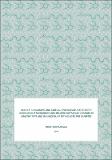Por favor, use este identificador para citar o enlazar a este item:
http://hdl.handle.net/10261/197092COMPARTIR / EXPORTAR:
 SHARE
BASE SHARE
BASE
|
|
| Visualizar otros formatos: MARC | Dublin Core | RDF | ORE | MODS | METS | DIDL | DATACITE | |

| Campo DC | Valor | Lengua/Idioma |
|---|---|---|
| dc.contributor.advisor | Ramos Romero, Sara | - |
| dc.contributor.advisor | Romeu Ferran, Marta | - |
| dc.contributor.author | Hereu, Mercè | es_ES |
| dc.date.accessioned | 2019-12-20T08:42:45Z | - |
| dc.date.available | 2019-12-20T08:42:45Z | - |
| dc.date.issued | 2019 | - |
| dc.identifier.uri | http://hdl.handle.net/10261/197092 | - |
| dc.description.abstract | Modern lifestyles in an increasing number of human societies include consuming an excess of saturated fats and refined sugars as well as enjoying microbiologically aseptic environments. Maintaining the appropriate distribution of gut microbial populations (eubiosis) is emerging as an attractive approach to prevent ectopic fat accumulation and insulin resistance (IR), and to avert the progression of diabetes. Functional food components are those that help maintain the normal bodily functions beyond providing energy or building blocks. They may bring about physiological health benefits for both healthy subjects following a healthy lifestyle and people belonging to risk groups such as obese or pre-diabetic populations. D-Fagomine is an iminosugar originally present in buckwheat with the capacity for selectively inhibiting bacterial adhesion to the intestinal mucosa. ω-3 Polyunsaturated fatty acids (PUFAs) reduce blood pressure as well as levels of insulin, triacylglycerols, cholesterol and total lipids. Iminosugars and ω-3 PUFAs may be used as functional food ingredients or dietary supplements to maintain a healthy status over time and to reduce risk factors for diabetes. This thesis focuses on the effects of buckwheat D-fagomine, fish ω-3 PUFAs (EPA/DHA 1:1) and their combination on the gut microbiota and related metabolic variables in the host both in healthy rats and a rat model of fat-induced pre-diabetes. In the first part of this thesis we explored the effects of D-fagomine and ω-3 PUFAs (EPA/DHA 1:1) on rats given a standard diet as a model for healthy subjects. We found that D-fagomine had the capacity for promoting microbial functional diversity by increasing the Bacteroidetes/Firmicutes ratio and for mitigating the age-related reduction in populations of the putatively beneficial Lactobacilliales and Bifidobacteriales. Also, the populations of the genus Prevotella remained stable over time in animals supplemented with D-fagomine, independently of ω-3 PUFAs supplementation. The combination between D-fagomine and ω-3 PUFAs provided the functional benefits of each supplement. Notably, it helped stabilize populations of Prevotella in the rat intestinal tract while reducing weight gain and providing the anti-inflammatory and cardiovascular benefits of ω-3 PUFAs. In the second part we explored the effects of the same supplements on rats with fat -induced prediabetes as a model for people at risk of suffering from diabetes and cardiovascular diseases. We found that D-fagomine delayed the development of a fat-induced pre-diabetic state by reducing lowgrade inflammation. We suggest that the anti-inflammatory effect of D-fagomine may be linked to a reduction in fat-induced overpopulation of minor gut bacterial groups such as Enterobacteriales. The 26 combined supplements counteracted the high-fat induced incipient IR, and liver inflammation, while increasing the cecal content, the Bacteroidetes/Firmicutes ratio as well as the populations of putatively beneficial Bifidobacteriales and Lactobacilliales. The functional effects of the combination between D-fagomine and EPA/DHA 1:1 against the gut dysbiosis and the very early metabolic alterations induced by a high-fat westernized diet were mainly those of D-fagomine complemented by the anti-inflammatory action of ω-3 PUFAs. The results of this thesis point clearly towards a functional role for D-fagomine in the maintenance of the intestinal health by preserving diversity and mitigating the age-related reduction of some beneficial bacteria and also in the prevention of risk factors for diet-induced pre-diabetes reinforced by the action of ω-3 PUFAs by complementary mechanisms. | es_ES |
| dc.description.sponsorship | This thesis was supported by the Spanish Ministry of Economy and Competitiveness (Grant AGL2013-49079-C2-1,2-R and a graduate fellowship to Mercè Hereu: BES2014-068592). | es_ES |
| dc.language.iso | eng | es_ES |
| dc.relation.isversionof | Publisher's version | es_ES |
| dc.rights | openAccess | es_ES |
| dc.subject | D-fagomine | es_ES |
| dc.subject | OMEGA-3 POLYUNSATURATED FATTY ACIDS | es_ES |
| dc.subject | Fat-induced Pre-Diabetes | es_ES |
| dc.title | ROLE OF D-FAGOMINE AND OMEGA-3 POLYUNSATURATED FATTY ACIDS ON GUT MICROBIOTA AND RELATED METABOLIC CHANGES IN HEALTHY RATS AND IN A MODEL OF FAT-INDUCED PRE-DIABETES | es_ES |
| dc.type | tesis doctoral | es_ES |
| dc.description.peerreviewed | Peer reviewed | es_ES |
| dc.contributor.funder | Ministerio de Economía y Competitividad (España) | es_ES |
| dc.relation.csic | Sí | es_ES |
| oprm.item.hasRevision | no ko 0 false | * |
| dc.identifier.funder | http://dx.doi.org/10.13039/501100003329 | es_ES |
| dc.type.coar | http://purl.org/coar/resource_type/c_db06 | es_ES |
| item.openairetype | tesis doctoral | - |
| item.languageiso639-1 | en | - |
| item.fulltext | With Fulltext | - |
| item.grantfulltext | open | - |
| item.cerifentitytype | Publications | - |
| item.openairecristype | http://purl.org/coar/resource_type/c_18cf | - |
| Aparece en las colecciones: | (IQAC) Tesis | |
Ficheros en este ítem:
| Fichero | Descripción | Tamaño | Formato | |
|---|---|---|---|---|
| ROLE OF D-FAGOMINE AND OMEGA-3 POLYUNSATURATED FATTY.pdf | Tesis | 10,81 MB | Adobe PDF |  Visualizar/Abrir |
CORE Recommender
Page view(s)
204
checked on 11-may-2024
Download(s)
290
checked on 11-may-2024
Google ScholarTM
Check
NOTA: Los ítems de Digital.CSIC están protegidos por copyright, con todos los derechos reservados, a menos que se indique lo contrario.
